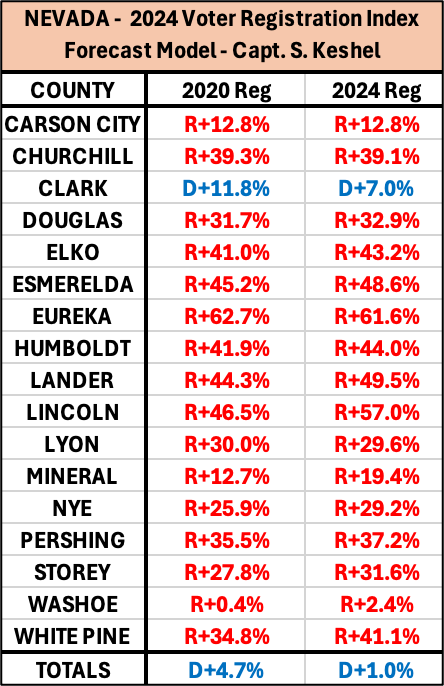A lead-in on Voter Registration by Party analysis, from my Voter Registration Index Forecast Model preview of Arizona:
Voter Registration by Party is the most accurate of all indicators in assessing the trajectory of upcoming presidential elections in a county or state. The logic goes like this: if a young black man registers to vote as a Democrat in Philadelphia in August 2008, who do you think he is voting for? If a white, non-college factory worker from Johnstown, Pennsylvania, switches from Democrat to Republican in September 2016, who do you think he is voting for? If you chose Barack Obama and Donald Trump, respectively, your thinking is correct.
Critics of this theory like to say, “you don’t have to vote Republican just because you’re a Republican,” and to some extent, that is correct. It takes a little discernment to understand each county and its intricacies. Please read my pieces on Westmoreland County, Pennsylvania, and last week’s introduction to the 2024 Voter Registration Index Forecast Model, featuring Pinal County, Arizona.
I published the pessimistic outlook for Nevada last month, which affords Harris a victory ceiling of 1.1%, or less than 17,000 ballots, against Trump. That outcome hinges on Clark and Washoe Counties, which together contribute seven out of eight votes statewide, booming with ballot growth for Harris resembling 2020’s growth, which isn’t necessarily likely for a variety of reasons. This piece focuses on likely outcomes based on registration analysis by county using Trump’s own registration to results coefficient, and soon, in a final piece just before the election, I will issue a formal projection blending all analytical disciplines, including using moreregistration data where necessary.
Nevada Voter Registration by Party
First, here is the shift in Voter Registration by Party since the 2020 quasi-election in Nevada:
Here is the current Secretary of State voter registration report, showing a Democrat lead of less than one percent, or +18,953 active registrations, down sharply from D+4.7% (+87,416) in 2020. This accelerated rapidly last month when the state’s voter rolls were purged following a lawsuit (to no one’s surprise, this disparately impacted Democrats). Nevada’s 16 counties plus Carson City (17 county equivalents) are all subject to Automatic Voter Registration, which has diluted Republican gains thanks to the addition of non-partisans who would otherwise not be registering to vote. That has pushed three heavily GOP counties slightly to the left in the registration index, but none of them have an organic leftward shift underway. Most importantly, Clark County (Las Vegas) and Washoe County (Reno) have major Republican movement underway which, even as significant as it is, doesn’t fully capture the potential shift of the Latino working class and unions toward Trump.
Analysis
From the original Arizona registration forecast:
When some polling outfit or angry media outlet picks up this article and scoffs at it, they should know that I’m simply relaying data that has absolutely no opinion attached to it. This part is the most hands-free part, whereas my pessimistic analysis took some proprietary effort, and my final, blended prediction will include some gut calls and updates to this article with the final voter registration figures that will be published ahead of Election Day.
In this piece, I am showing you what the results are likely to be given the shifting of voter registration by party and Donald Trump’s two known performances relative to the registration indexes.
Here is my model for Douglas County, a Republican stronghold in western Nevada:
Douglas County has backed every Republican nominee since 1940, and in this selection of six cycles, the reader can see that the final Republican margin is always to the left of the Republican voter registration lead. For example, Trump won Douglas by 9,061 in 2016, and by 10,059 in 2020, with the first being 503 votes to the left of the registration advantage and the second, 2,266 (amplified thanks to election “fortification”).
That average, for Trump-specific races, comes out to 1,385 to the left of the registration advantage. Right now, the Republicans have a +13,673-registration advantage (R+32.9%) in Douglas County, which may clear 14,000 by Election Day. Trump’s 1,385 coefficient average subtracted from the registration advantage of 13,673 leads me to conclude Trump’s optimistic number is +12,288 (+36%) in Douglas County, which would up his margin by +2,229 from 2020.
Here is how the entire 17-county equivalent field shakes out, calculated the same way:
Keep reading with a 7-day free trial
Subscribe to Captain K's Corner to keep reading this post and get 7 days of free access to the full post archives.





